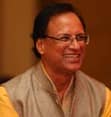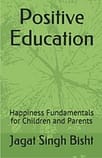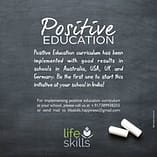Shri Jagat Singh Bisht
(Master Teacher: Happiness & Well-Being, Laughter Yoga Master Trainer, Author, Blogger, Educator, and Speaker.)
Authored six books on happiness: Cultivating Happiness, Nirvana – The Highest Happiness, Meditate Like the Buddha, Mission Happiness, A Flourishing Life, and The Little Book of Happiness. He served in a bank for thirty-five years and has been propagating happiness and well-being among people for the past twenty years. He is on a mission – Mission Happiness!
☆ Positive Education # 01: Fundamentals of happiness and well-being for children and their parents ☆
Description
Do you wish to prepare your child with life skills, such as, grit, optimism, resilience, growth mindset, engagement, and mindfulness? A combination of traditional education with the study of happiness and well-being can be of great help in this regard.
Children and parents can flourish in life with the help of happiness activities that may be easily practised. The concepts are derived from Positive Psychology, the modern science of happiness and well-being, and Positive Education, an approach to education that blends academic learning with character and well-being.
Positive Education focuses on specific skills that assist students to strengthen their relationships, build positive emotions, enhance personal resilience, promote mindfulness, and encourage a healthy lifestyle. The concept has support from a range of prominent psychologists and practising teachers.
There are books for children and there are books for the grown-ups. This one is for both of them – the children and their parents. The book may also be used for implementing positive education in schools.
Fundamentals of happiness and well-being for children and their parents
“There is no end to education. It is not that you read a book, pass an examination, and finish with education. The whole of life, from the moment you are born to the moment you die, is a process of learning.”
J Krishnamurti
This is a book describing the fundamentals of happiness and well-being for children and their parents. It is to be read individually as well as collectively by them so as to have a true understanding of happiness and how to flourish in life.
Usually, there are books for children, and there are books for the grown-ups. This book is different. It is for both of them – the children and their parents. Each one reads and understands from his/her own perspective and then there is friendly sharing of learning amongst them for better understanding. It creates joy and bonding. The effects on long-term happiness and well-being of the family are deep rooted and robust.
The concepts are derived from Positive Psychology – the modern science of happiness and well-being – and Positive Education – an approach to education that blends academic learning with character and well-being.
All parents want the best for their children, they want their child to be happy and flourish. However, finding the right education for their child can be a challenge.
The Geelong Grammar School in Victoria, Australia, in consultation with world experts in positive psychology, developed a model for positive education to complement traditional learning.
It is essentially an applied framework comprising six domains:
- positive emotions,
- positive engagement,
- positive relationships,
- positive purpose,
- positive accomplishment,
- and positive health.
Each of these six domains are explained and elaborated in the book. The emphasis is on how to cultivate each one of these practically and enhance happiness and well-being.
A good school doesn’t just aim for its students to achieve their academic potential. It also aims to develop them as caring, responsible, and ultimately productive members of society.
Positive education curriculum has been implemented with good results in schools in Australia, USA and Germany. Widespread support is necessary for the success of the positive education movement.
This book may also be used as a well-being primer by teachers and educators for implementing positive education in their schools. It will enable the students to develop an understanding of authentic happiness and flourish in life.
“God gave us the gift of life; it is up to us to give ourselves the gift of living well.”
Voltaire
♥ ♥ ♥ ♥
© Jagat Singh Bisht
Master Teacher: Happiness & Well-Being, Laughter Yoga Master Trainer, Author, Blogger, Educator, and Speaker
FounderLifeSkills
A Pathway to Authentic Happiness, Well-Being & A Fulfilling Life! We teach skills to lead a healthy, happy and meaningful life.
The Science of Happiness (Positive Psychology), Meditation, Yoga, Spirituality and Laughter Yoga. We conduct talks, seminars, workshops, retreats and training.
≈ Editor – Shri Hemant Bawankar/Editor (English) – Captain Pravin Raghuvanshi, NM














